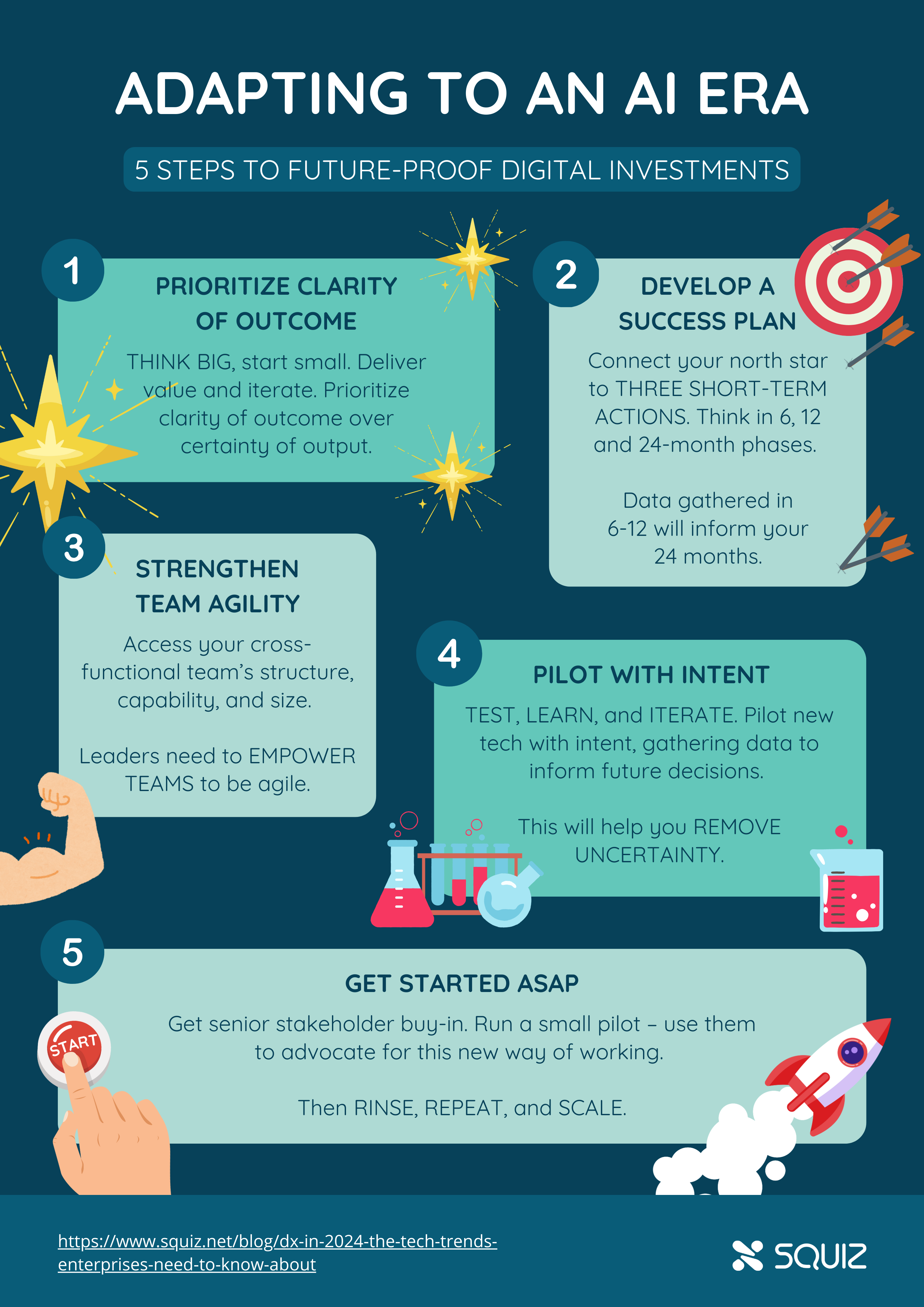Welcome to the AI Era. It’s a time that demands unprecedented agility and adaptability.
And it presents two major challenges for digital experience teams:
- Keeping up with the pace of change
- Identifying the right tech to help
Success requires a fundamental shift – new mindsets centered on iterative planning and piloting tech to prepare for the unknown.
This blog explores the strategies, structures, and stakeholder management required.
Short on time? Here’s a TL;DR infographic.
Clarity of outcome vs certainty of output
The Squiz report ‘DX in 2024: a practical guide for digital experience professionals’ leads with the primary trend, ‘The death of the future’. A pretty alarming statement – but necessary to highlight the extreme pace of change and challenge of long-term planning.
Tech is evolving at speed, major market shifts occur frequently and customer expectations are accelerating rapidly. The digital experiences we offer have to keep up.
Traditional long-term strategies driven by lengthy deployment roadmaps are no longer an option.
A new approach
Squiz empowers customers to embrace a more iterative approach with ‘success plans’. The idea is to connect your goal, the North Star (what you're trying to achieve), through to action on a relatively short time horizon in a way that provides flexibility for change.
Develop 6, 12, and 24-month plans – but approach each phase differently. Your 6-month plan will have the most clarity and certainty. Your 12-month plan will see you loosely fix goals. Finally, your 24-month plan will be informed by the data gathered from your 6 and 12-month activity. This allows for flexibility and changes to your output.
Chris Howard – Managing Director of Data Analytics and AI at Slalom, describes this approach as opting for ‘clarity of outcome over certainty of output’.
The agile organization
To enable organizations to pivot, leaders need to adopt a more ‘agile’ approach, but not in the way you might think. The meaning behind this is two-fold:
1. Adopt agile architecture
Create an architecture resilient to change
“Architect in a way that assumes you will swap parts of your architecture in and out over time. Then, assess what might break when you do so. When selecting new technologies and solutions, pick those designed to be resilient to change.” – John-Paul Syriatowicz, co-founder and chairman of Squiz
Start by designing your systems around these five principles:
- Modularity: The system is divided into smaller, coupled components or services that can be developed and maintained separately.
- Reusability: Components are designed to be reusable across different parts of the application or even across multiple applications.
- Flexibility: Components can be easily added, removed, or replaced without affecting the entire system, allowing for greater flexibility and adaptability.
- Scalability: Individual components can be scaled independently based on their specific requirements, improving overall system scalability.
- Ease of integration: Components expose well-defined interfaces or APIs, making it easier to integrate them with other components or external systems.
But don’t stop there….
There are many platforms that enable this approach through development. But by doing only this, you risk creating gaps or trade-offs. You become overly dependent on developers, you may introduce security and governance concerns, and you will likely encounter usability problems - since each piece of tech has its own UI and ways of working.
We're also operating in a world where content resides in multiple systems. In large, complex organizations, one dream (and major challenge) is having centralized access to content and collaboration throughout the content creation pipeline.
To avoid these trade-offs and challenges, you need to operate from a framework or platform that directly mitigates them. It assumes shifts will occur, enables centralized governance and ensures that any infrastructure stays relevant as systems change over time.
If you’re building systems on the five principles above via a centralized platform or framework, you’re creating an architecture that is resilient to change.
2. Create an agile culture
Assess your cross-functional teams
How your teams are constructed and managed can have a huge impact on their ability to be agile. You need to assess whether you, as a leader, are providing the right resources, training, and management.
Consider – are they:
- Self-organizing?
- Autonomous?
- Dependent on many others?
- Able to move quickly and resolve for unknowns?
Consider how teams communicate e.g. the frequency and openness of those comms.
“This isn't just about technology, it's a philosophy. It's, it's the right approach. It's the attitude that you have to how you act and the guiding principles that drive your behavior. And that's, that's probably where this gets quite emotive for some it's, that philosophical nature of what is agile. ” – Chris Howard, managing director at Slalom.
Bringing your organization on that journey
You’ve set your team up for success. Now you need to ensure your colleagues are on board for this change. How can you cultivate a new way of thinking in your organization?
Chris Howard talks about one approach of simple advocacy. You need an employee to champion your new way of working. But you also need evidence and data.
A small pilot program is the key.
- Find a department within your organization with a meaningful problem to solve – it needs to be of a size and scale that is meaningful, but not overwhelming (you want to actually get some good results on your first go!).
- Make sure you have a willing volunteer to manage and champion this pilot – choose someone proactive and with a level of authority to run with a pilot.
- Be really clear on the ‘why’ – if we solved this problem, what would that allow us to do? There has to be value.
- Run the pilot with your new agile approach – ensure your champion runs this pilot in a very iterative, agile approach. Be clear on the outcome, but not necessarily the journey. Pivot and change as you gather more data and document this.
- Success! Then sell this journey across the business – now you have your first pilot and a new advocate, you can sell this approach to the rest of the business.
- Rinse and repeat – with clear evidence that this approach works, scale this across the organization, and use that individual to drive advocacy and champion that approach.
Your CMOs, CTOs, and CFOs may be concerned about the efficiency, quality, and cost of running a new approach. But starting small and iterating allows you to appease these stakeholders by experimenting at a low-risk level before scaling.
“This is a way of offering to reduce cost. Risk and time to delivery. We know it’s risky to plan long-term in the future and require lots of resources. This is a framework for reducing that risk, making it simpler and showing outcome and output quickly” – John-Paul Syriatowicz, co-founder and chairman at Squiz.
From playing to piloting – the imperative of experimentation
Trend 2 in the DX guide talks about the need to shift from playing with new tech, to piloting with intent.
We know the rise of accessible tech has allowed us to ‘play’ with more tools – adding greater efficiency to our workflows e.g. marketers are creating web copy at speed and developers are using AI to write code.
But now, many organizations are getting stuck in a cycle of endless experimentation without practical application.
In early 2023, Gartner conducted a study with 2,000 execs globally – 70% of organizations were building awareness of Gen AI, 15% were experimenting, and 5% were taking applications forward.
At the end of 2023, Gartner predicted by 2026, 80% of organizations will have deployed either a Gen AI model, be using a generative AI API, or embed that technology into their own applications.
That jump from 5% to 80% in just 12 months, is huge. So, how can organizations shift from playing to implementing?
Piloting new tech needs to be done with intent. Aligning on the ‘why’ and desired outcome is critical before chasing AI for technology's sake. Think first, “Is this new piece of tech going to make me more agile?” If so, why?
Whether it's leveraging AI for enhanced data analytics, improving customer engagement through chatbots, or any other application, the focus should be on solving specific problems and achieving desired outcomes, rather than being driven by the novelty of the technology itself.
“Pilots are a great way to remove uncertainty. Uncertainty is a lack of data that allows us to move forward and make meaningful decisions. Experimenting allows us to pose a hypothesis, capture data, and then prove or disprove that hypothesis. Finally, use this data to inform your next decision.” – Chris Howard, managing director at Slalom.
One thing senior leaders can do TODAY
Advice on how to keep up is great but, as always, getting started is often the biggest hurdle. So, we asked John-Paul and Chris for one thing they recommend senior leaders do right now to make progress in navigating the AI era.
Here’s what they said….

Build a data strategy
Irrespective of what you're buying into or the tooling and the technology that you choose to deploy, your data is the thing that differentiates you from everybody else.
Focus on building out a really comprehensive data strategy that ensures your data is accessible, consumable, trusted, and secure. Because the technology will evolve and change. What you use today will not be what you're using tomorrow, but you will still need to present your data to that technology, whether it's an AI model, API, or something else.

Don’t prioritize AI as the solution
You should be using AI, but don't prioritize it as a solution. First, assess the outcome you’re trying to achieve. Consider, what needs to happen to achieve that. Then, ask yourself, “Can AI substantially accelerate this?”
AI is not always the answer.
We see this advice echoed by Gartner, “the hype surrounding generative AI can lead to use of the technology where it is not a good fit, increasing the risk of higher complexity and failure of projects.”
Conclusion
The AI-driven future is uncertain, what is certain is that embracing agility and piloting AI with intent will be critical for organizations to stay ahead of the curve. With a strategic, outcome-focused approach, digital teams can navigate this era successfully.
Steps to achieve this? Let’s recap:
- Adapt your long-term strategy – move from long-term plans to an iterative approach that allows for change. ‘Clarity of outcome rather than certainty of output.’ Use a success plan methodology to get started.
- Measure team agility – embrace agility in both culture and strategy. You need to assess your team’s ability to be agile – consider if you’re empowering them to do so e.g. the structure, capability, and way they work. Also, allow your strategy to be agile. Consider your architecture, governance, and content orchestration.
- Get started – get your stakeholders on board with a simple pilot program. Find your internal champion and get them to advocate for this new way of working. People need to see it to believe it!
- Pilot with intent – break out of the cycle of endless experimentation without practical application. Consider why you need to pilot that tech – will it help you be more agile? Then, use the data from the pilot to inform your future pilots.
Learn more about embracing agility and piloting tech from John-Paul and Chris in this recorded Ask Me Anything session.

